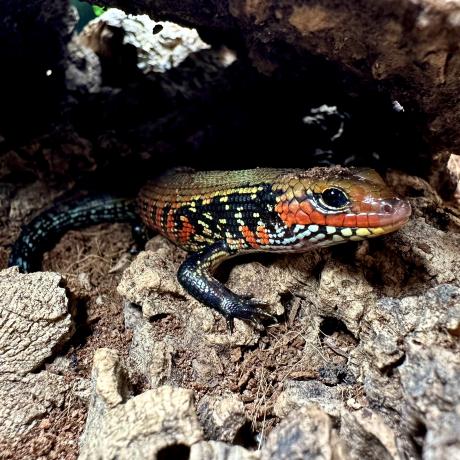

The True Fire Skink has to be one of the most beautiful species of lizards with their vivid red colouration. They become very tame and have an inquisitive nature, especially when it is feeding time.
The True Fire skink is a stout, square bodied skink with short limbs. The dorsal (back) and head is a golden brown merging into a fire red colouration that runs along the body. Black and white bands run horizontally giving a distinctive pattern within the vivid red colour. The tail has a mixture of colour; it is mainly black with lighter scales running the length of the tail giving a stripe appearance. The limbs are black, the underbelly is pale with grey striping under the chin and throat.
They are a reasonably sized skink reaching a maximum length of 38cm (15 inches), however, most average between 20-30cm (8-12 inches). Both sexes look very similar, the only difference, males tend to be bulkier in appearance, have a wider neck and a flat head. True Fire Skinks are relatively docile and calm lizards, frequently coming out from their resting place to be hand-fed.
There are three known species of Fire Skinks, all from slightly different areas of Africa.
The True Fire Skink that is seen within the pet trade are normally collected from Nigeria and Ghana. They live in tropical forests and damp savannas, generally burrowing amongst floor leaf litter and hiding under debris.
For this terrestrial species we would recommend a minimum enclosure size of 3ft to allow space for the skinks to roam, this can be either a wooden vivarium or a glass terrarium, however a 4ft enclosure will be readily enjoyed by the skink.
Research shows that UVB exposure contributes to healthy animals, both mentally and physically. We advise the use of UVB lighting within the parameters of Ferguson Zone 2. The use of a T5 lighting kit is recommended due to the skink being diurnal (active during the day). Providing 12 hours of UVB light will also help simulate a natural daylight cycle and will aid calcium absorption via access to natural D3.
The enclosure can be heated with the use of a basking bulb; during the day a basking area of 33-35.5C (92-96F) should be provided with an ambient temperature of 28.5-30C (84-86F). A night time drop is recommended to around 21C (70F), however, True Fire Skinks seem to tolerate lower temperature down to 18.5C (65F). This can be maintained with the use of a ceramic bulb. All heating elements should be connected to a thermostat to prevent accidental overheating.
The flooring of the enclosure needs to allow the skinks to burrow, we would recommend a soil substrate, orchid bark and leaf litter mix. They do require a slightly damp substrate, but this must not be waterlogged nor too dry and dusty as this can cause eye and shedding problems. You ideally require the bottom layer to be moist at around 60-70% humidity, the surface layer can drop down to 40%, regular misting we help maintain this. Another good way to prevent any shedding problems is to have a humidity hide with damp moss within the enclosure.
In the wild these skinks are quite secretive and will often hide within fallen logs and branches, reptile caves and skulls make a great retreat. Although a ground-dwelling species, they are good climbers, therefore provide some branches to help keep them active. Dense foliage provides plenty of hiding and hunting opportunities for this shy species. Adding in a drainage layer for bio-active setups, a soil based substrate to cover the floor and then a layer of leaf litter and moss on top can help to retain moisture within the setup, without the substrate becoming saturated and stagnant. Cork bark branches and vines also work well, adding to the natural look of any forest habitat and providing vertical climbing space. Artificial plants are also ideal for adding plenty of coverage in areas of the tank which look a little sparse, especially while live plants are getting established.
Feeding is very easy as they have a great appetite; a range of insects can be offered along with the odd pinkie mouse. Ensure you use a good vitamin and mineral supplement once a week, calcium can be added on all other feeds. Chopped up fruits and meal replacement powders can also be offered. Provided a shallow water dish and replace the water every few days or when soiled.